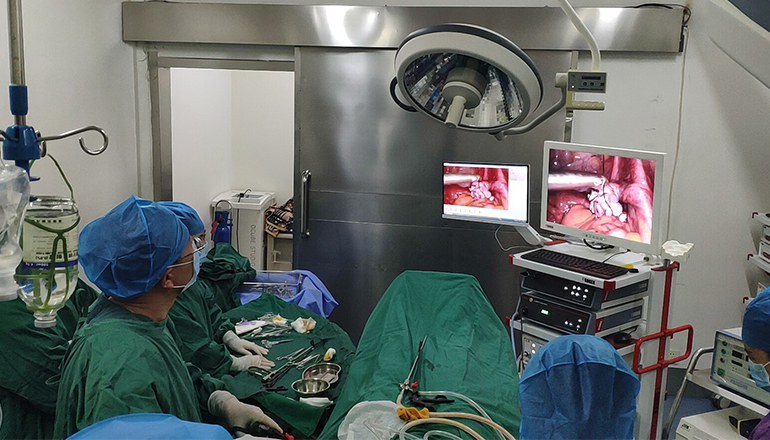- Shanghai, China
- [email protected]
- +86-21-58189111
Gynecological laparoscopic ovarian cyst pedicle torsion operation, also known as laparoscopic detorsion of ovarian cyst, is a minimally invasive surgical procedure used to treat ovarian cysts that have become twisted or "torsed." Ovarian cysts are fluid-filled sacs that form on or inside the ovaries. They are usually benign and do not cause any symptoms, but in some cases, they can become enlarged or twisted, causing pain and other complications.
When an ovarian cyst becomes twisted, it can cut off the blood supply to the ovary, causing severe pain and potentially leading to tissue death. In such cases, immediate medical attention is required to prevent permanent damage to the ovary. Laparoscopic detorsion is a procedure that is performed under general anesthesia and involves making several small incisions in the abdomen to insert a laparoscope, which is a thin, flexible tube with a camera and light on the end. The surgeon uses the camera to guide the laparoscope to the ovary, where they can visualize the twisted cyst and detorse it.
During the procedure, the surgeon will carefully untwist the cyst and release any tension on the pedicle, which is the stalk that connects the cyst to the ovary. If the cyst is too large to be detorsed, the surgeon may need to remove it completely. In some cases, the ovary may also need to be removed if it has suffered significant damage due to the torsion.

Laparoscopic detorsion is a safe and effective procedure with a low risk of complications. It is often performed as an outpatient procedure, which means that the patient can go home the same day. After the surgery, patients may experience some pain and discomfort, which can be managed with pain medications. They may also need to take antibiotics to prevent infection.
Recovery time after laparoscopic detorsion varies from person to person but is typically shorter than with traditional open surgery. Most patients are able to return to their normal activities within a few days to a week. It is important to follow the surgeon's post-operative instructions carefully to ensure proper healing and prevent complications.
In conclusion, laparoscopic detorsion of ovarian cyst is a minimally invasive surgical procedure used to treat twisted ovarian cysts. It is a safe and effective option for treating this condition, with a low risk of complications and a shorter recovery time compared to traditional open surgery. If you are experiencing symptoms of an ovarian cyst, it is important to seek medical attention as soon as possible to prevent complications and ensure the best possible outcome.
In some cases, the surgeon may recommend additional treatment after laparoscopic detorsion, such as hormonal therapy or further monitoring to prevent the cyst from recurring.
It is important to note that laparoscopic detorsion is not appropriate for all cases of ovarian cysts. The decision to perform this procedure will depend on the size and type of the cyst, as well as the overall health and medical history of the patient. In some cases, traditional open surgery may be necessary to treat the cyst.
In summary, gynecological laparoscopic ovarian cyst pedicle torsion operation is a minimally invasive surgical procedure that can be used to treat twisted ovarian cysts. It is a safe and effective option with a low risk of complications and a shorter recovery time compared to traditional open surgery. If you are experiencing symptoms of an ovarian cyst, it is important to seek medical attention as soon as possible to prevent complications and ensure the best possible outcome. Your doctor can help you determine the best course of treatment for your individual case.
Leave a Comments